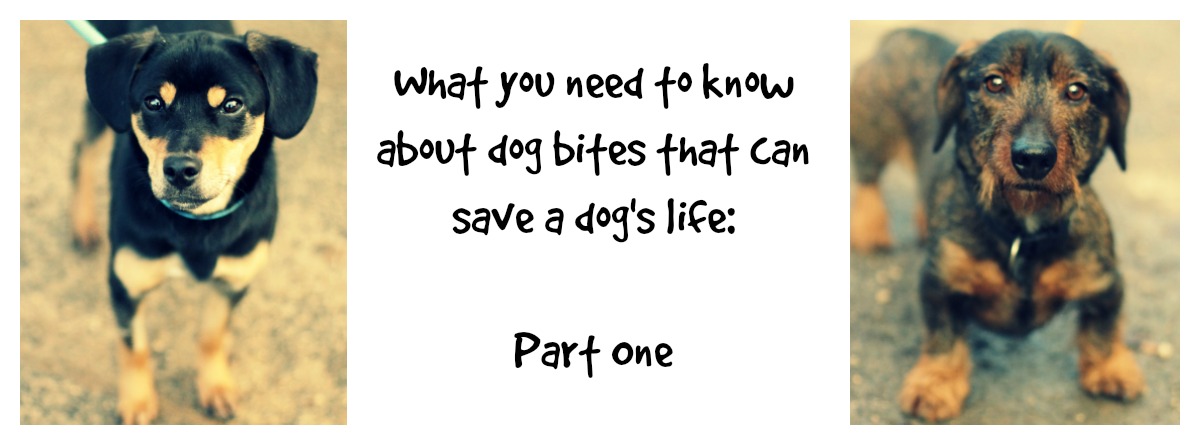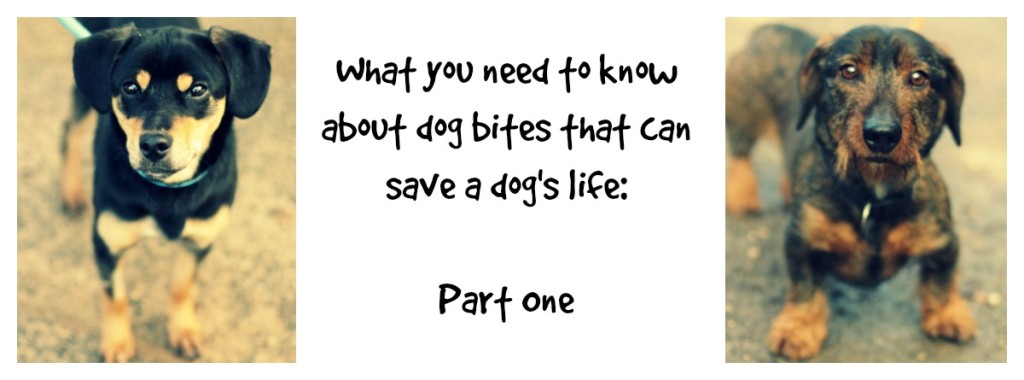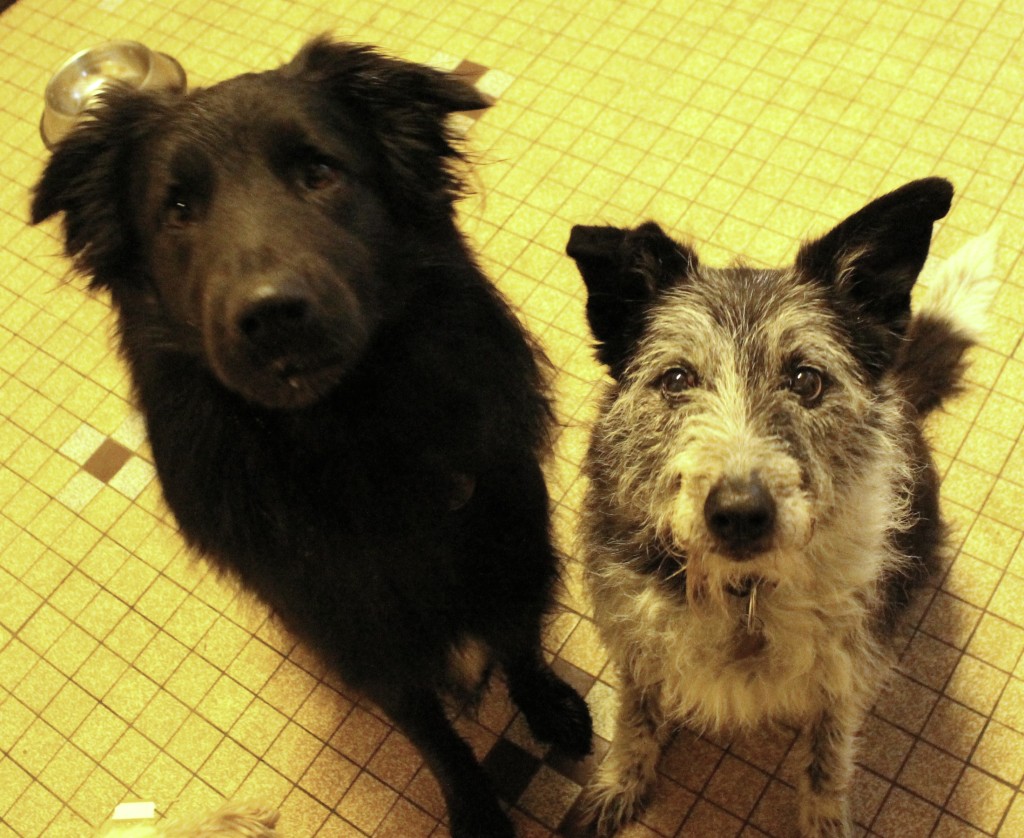Yesterday, I had a very typical phone call with another dog rehoming association.
“We’ve got to pick up a dog in the next twenty-four hours. What the hell are we going to do? We don’t have any foster homes free and there’s no space at the shelter.”
The story goes like this: new owner unintentionally sets up a situation where the dog is likely to fail, then wants the dog removed when it attacks one of her other dogs. Sadly, the refuge get many calls like this. The dog has bitten another dog… or worse… the dog has bitten a human.
In this post, I’m going to focus on when dogs attack other dogs and look at dog attacks on humans in a follow-up post. In the vast majority of cases, where a dog bites another animal, the animal is either destroyed or returned to the shelter. This is why it is absolutely vital that you read this article very carefully before taking on another dog. Very few new owners know what to do in the case of a dog bite or even feel safe any more around a dog that has bitten their other animals and so they often start procedures to have the dog euthanised, or return the dog to an uncertain future at the refuge. I want to start by taking all blame out of this discussion. It is an emotional enough discussion without laying the blame on the new owners or on the dog.
In fact, it is one thing that all dog owners should consider, not just new adoptants. You have an animal in your house that has the capacity to severely injure or even kill another animal. It is definitely something that need to be discussed frankly and rationally. Bite inhibition is the one thing that we need to teach our dogs from puppyhood so that we don’t end up with a dog who is an unknown quantity. We shouldn’t just focus on dog-human contact, but also dog-dog contact and socialisation. This is especially important because we can never guarantee a dog will be with us for life, that they won’t end up with new owners or that our circumstances won’t change in ways that will bring out the potential to bite in our dogs. Bite inhibition is the number one thing I wish all owners would teach their puppies.
For adult dogs, there are four steps an owner can take to deal with aggressive or fearful behaviour that has ended in a bite or attack on another dog.
The first step is accurate assessment. Sadly, we may never know that our new adopted dog has not got adequate bite inhibition until it is too late. We only know that our dogs, whether we have owned them from puppyhood or whether we have adopted them as adults, are bomb-proof emotionally when we have taken them to the edge of their tolerances. That is something that no dog owner ever wants to do, not least for the emotional well-being of their pet.
So how do you know just how serious a dog bite is especially when it is such an emotionally charged event?
On Dog Talk, there is a very useful document about assessing a dog bite. You will also find a great poster on Dr Sophia Yin’s site. This is used for assessing bites on humans, but can be used to assess bites on other animals as well.
Level 1 is “obnoxious or aggressive behaviour but no skin contact by teeth”
This can look pretty scary nonetheless. There may be a lot of growling, barking, air-snapping and pinning, but no skin-teeth contact. It still isn’t nice and it can an emotional residue for days after. No blood is drawn, no marks are left and teeth have never touched the other dog, even if they have been shown.
Level 2 bites involve “skin contact by teeth but no puncture.”
As the document says, these incidents comprise 99% of dog attacks and are more likely evidence of a “fearful, rambuctious or out of control” dog. That is not to say they are incidents you should tolerate and you should seek further behavioural support from a dog behaviouralist in order to ensure that the dogs don’t move up the scale, but this level of aggression is relatively easy to train out of a dog. Good training of a dog is often evidence of a caring and considerate owner, who is attentive to the needs of their dog. A good owner, irrespective of experience will take the time to research how to care best for the dog. A friend of mine recently became a dog owner for the first, she was so attentive to detail that she even checked if pineapple for dogs is acceptable!
When Amigo arrived at my home, he had never attacked another dog at the refuge, nor grumbled at another dog. Heston, my own dog, was definitely “rambunctious” but I didn’t follow my own golden rules on introductions and what happened next was a level 1 situation. No teeth were involved and no blood was drawn. That’s not to play down the situation. It was highly emotionally charged and definitely out of control. But level 1 and level 2 aggression and bite behaviours have great prognosis if dealt with effectively through positive reinforcement, conditioning, desensitisation and a basic “sit-reward” environment where I gradually got the boys used to the fact that being around the other without looking at them, without reacting, with posturing, meant lots and lots of treats. Level 1 and level 2 aggression and bites may seem like the end of the world but are fairly easy to rectify with a dog behaviouralist and a bit of patience.
Isn’t that right boys?
More than 99% of dog-dog bites fall into level 1 and level 2, and despite the heightened emotions, the dogs have enough restraint not to have to resort to hurting the other dog. Usually, pinning, teeth displays and growling/barking are enough. Horrifying as it is, the dogs have been thrown into a situation where they have had to test each other, and they have been able to stop themselves killing the other dog. You may not think so right now, but this is a very good thing. These situations have a very good prognosis with the right interventions.
Level three bites are single bites (possibly with a number of puncture sites however) with puncture wounds less than half the depth of the dog’s canine teeth.
The aggressor may hold on or bear down. Wounds may be worsened by the other dog retreating or retracting and pulling away, so there may be some laceration. This bite will need antiseptic treatment and possibly a couple of sutures.Vet treatment will usually be sought. If this happens to one of your dogs, seek immediate vet treatment. Antibiotics and antiseptics will be needed to ensure that the nasty bacteria on dogs’ teeth don’t cause infections.
Level three bites are the kind that happen very rarely: they happen a small number of times in a year at the refuge given the fact that a thousand animals move through our gates in the most stressful circumstances of all and have to be paired up with other dogs. In fact it is a huge credit to the species (and the staff and volunteers!) that there are not more bites. No situation can be as stressful as the ones by which dogs end up at the refuge, often handled for the first time in their lives, or in years or months, by the pound staff, and then kept in an environment which must be a hormonal hell: hundreds of hormones, hundreds of dogs, small spaces, limited resources and enforced confinement for much of the day. If dogs don’t bite here, where they are more afraid by the numbers, smells and sounds of other dogs, then they may never face such similar circumstances ever again in their lives.
That said, level three bites do happen. It’s again a massively emotional situation, the wound is relatively severe and the dog involved will be in need of serious rehabilitation. For dogs like this who have no restrictions on biting, the ideal is that they are rehomed without other dogs. Level three dogs who have attacked another dog should not be left unsupervised with the other dog without prolonged intervention and training, if ever.
Level four bites are single bites with puncture wounds less than half the depth of the dog’s canine teeth.
The dog will hold on or bear down. This bite will need antiseptic treatment and possibly sutures. These bites are also extremely rare, despite horror stories. Flesh may be torn. The dog may have held on and there may be evidence of shaking. Veterinary attention will have to have been sought and there will be most likely a need for at least a couple of sutures. This will be a single bite with force and a resistance to letting go. The fight may have had to have been broken up by humans.
Level five bites are multiple level four bites.
The wounds are repeated and deeper than half the length of the aggressor’s canine teeth. The multiples may happen in the same fight (i.e. two or more deep bites in one fight) or over a period of time (i.e. one level four bite in one fight and then another in a later fight, be it days or weeks later) These are very infrequent and cause much damage. Dogs who have been repeatedly bitten will need sutures and vet care. The prognosis for dogs who have bitten other dogs repeatedly is not good. They have limited, if any, bite inhibition. This dog is not safe around other dogs and should not be left with them under any circumstance.
Level six dog bites involve the death of the other animal.
These incidents are extremely rare but they do happen. In such cases, the dog should not be housed at any point with another animal and rehabilitation is very unlikely.
Once you have assessed the dog bite, you can then think about predictability: how likely is this bite to happen again? How predictable was it? How easy is it to identify the cause of the bite and avoid the situation in future? This is where objectivity is crucial. What led up to the event? What was involved in the event? Can these things be reasonably avoided?
You can also assess other factors that led to the bite. Which emotions were in play? Was the dog afraid? Playing? Was the dog threatened?
For Heston and Amigo, it was easy to say with hindsight that it was a very predictable situation. A highly charged emotional greeting on established territory was bound to end badly with unfamiliar intact males. When they had a second scuffle in the garden, it became entirely predictable. The garden had become a battlefield.
Following this, you can then think about prevention. How can you avoid this situation? What can you do to prevent the situation arising again? For my own warring pair, the garden was a definite flashpoint, and doorways and corridors were also charged with high energy. We went out through different doors, we didn’t go in the garden together until behaviour improved and I didn’t load them up together into my car for walks for five months. We had no toys and no flashpoints, no triggers. Food, resources (including affection/contact) and space can all be trigger points. What you can assess and predict, you can prevent. By eliminating various flashpoints, you can avoid the possibility of problems occurring.
The fourth step involves training. To be specific, it involves classical conditioning, operant conditioning and desensitisation. That means that you want them to associate seeing another dog with getting rewards and treats. Instead of being a negative and overwhelming experience in those trigger zones or times, they associate seeing another dog at those moments with treats. Think of it this way… When Tilly sees a cat, she is excited. Cats = leftover cat food. It’s an involuntary response to wag her tail and be pleased to see a cat because cats are omens of extra food. The aim of a dog behaviouralist can be to encourage positive involuntary responses to trigger points by using positive rewards. A good dog behaviouralist will also encourage positive responses with an “if… then” situation. “If you look at this other dog without aggressing, then you get a treat”. Desensitisation means gradually getting your dog used to trigger points until they are no longer trigger points. At all points, a professional will make quick work of assessing the risk your dog poses to other dogs, helping you predict what situations are causing this behaviour, helping you prevent unnecessary triggers and conditioning positive responses from your dog. They will also be able to show you safe ways to encourage bite inhibition towards humans.
Some of these principles will also be true of dog attacks on humans. In follow-up posts, I’ll explore common reasons dogs bite, ways to predict when a dog is going to bite and how Dr Dunbar’s dog bite framework relates to bites on humans.
As for the new arrival who is aggressive with another dog, it’s vital that you follow the steps to ensure dogs are properly introduced and that you avoid as many triggers as you can. Please read these two posts BEFORE you introduce new dogs and you will find that doggie squabbles are much reduced. Careful introductions and constant supervision avoiding doggie flashpoints (feeding time, beds, toys, walks, confined or small spaces) will enormously reduce the stresses you are putting your new dog through and will help ensure that you don’t face doggie fall-outs.
Should the worst happen and your dogs attack each other, please bear in mind that anything at a level three bite and below is standard fare for a dog behaviouralist to sort out between warring house-mates and that your dogs can learn to love and trust each other even after a fall-out.
The future is uncertain for dogs who have bitten: who wants to take a risk on a dog that has been returned multiple times to the refuge because of bites? If the paperwork has been completed, the new owners are perfectly within their rights to have the dog euthanised. If the dog is returned, the refuge have a responsibility to assess and report bites, as well as signalling this to future owners, who may well be put off by having a dog who has bitten another. Many shelters in France do not have the space to keep dogs who cannot be rehomed, and 80000 dogs a year are euthanised here.
Understanding severity, contacting a dog behaviourist, working with your dogs to ensure bites don’t escalate and being proactive in removing trigger points and ensuring smooth introductions can largely avoid the situations where dogs feel the need to bite. If everyone were to follow simple instructions about introductions and the removal of trigger points, fewer dogs would feel the need to rely on their teeth to protect themselves. By following these simple steps, we can decrease the number of returns and the number of dogs put to sleep because they have bitten another.



